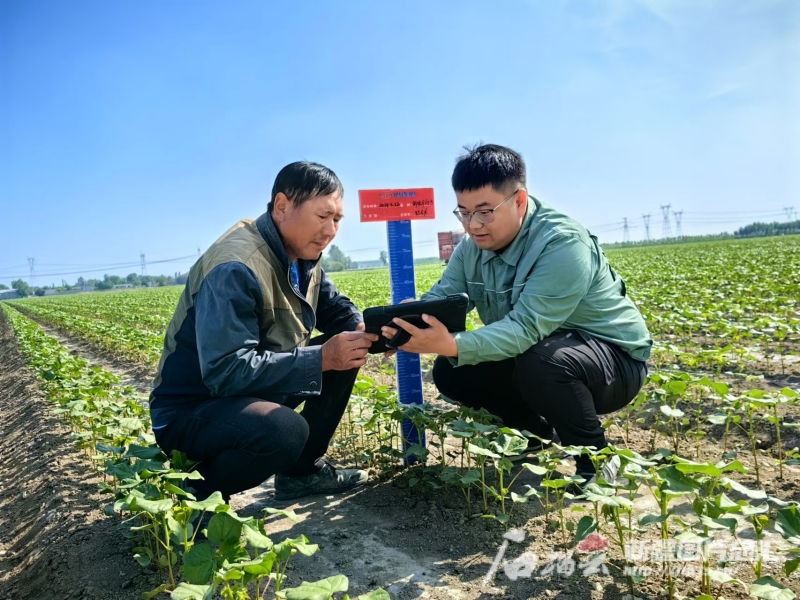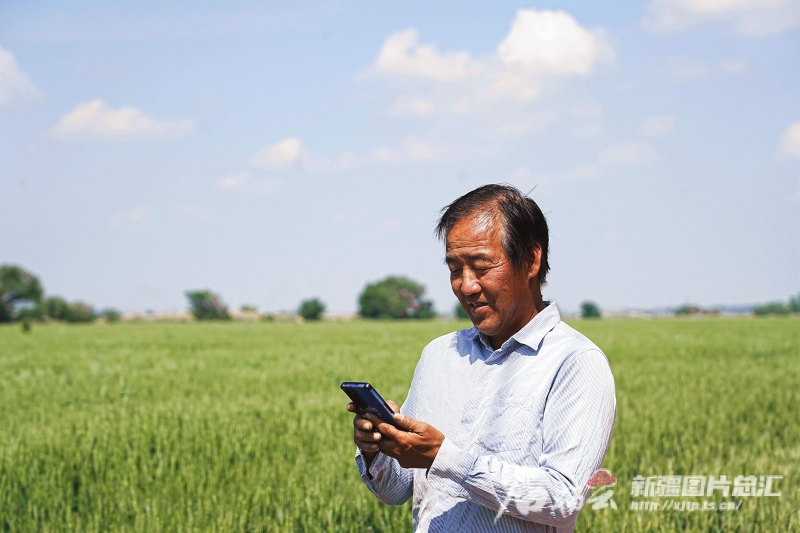Shiliuyun-Xinjiang Daily (Reporter Ge Youjun, Correspondent Wang Wei) news: On July 4, 2024, over the vast cotton fields in Heiliang Village, Letuyi Town, Manas County, Changji Hui Autonomous Prefecture, northwest China‘s Xinjiang Uygur Autonomous Region, several drones were seen flying along pre-planned routes, efficiently spraying chemical topping agents. The operation is simple, quick, and highly efficient, exuding a strong sense of technological advancement.
"Our cooperative has planted cotton on 48,000 mu (about 3,200 hectares) of land, yet only requires 50 people for management. From planting to harvesting, the entire process has been mechanized," said Ma Tao, the chairman of the Lesheng Planting Cooperative in Manas County, looking calmly at the drones working in the fields.
Up to now, the Lesheng Planting Cooperative has purchased over 20 sets of agricultural machinery worth nearly ten million yuan (about 1.37 million U.S. dollars), including the widespread adoption of various modern agricultural production technologies such as the BeiDou Satellite Navigation System, smart irrigation, and drone-based plant protection services.
In Manas County, the application of digital agricultural technology extends far beyond these examples. An increasing number of farmers are starting to use cloud computing technology to upload land planting data to the cloud. This allows them to use dynamic data to guide production, thereby achieving high yield, high quality, and high efficiency in agriculture.

Photo taken on May 23 shows Zhang Baoshuai (right), an agronomist from Xinjiang Xinlianxin Energy and Chemical Co., Ltd., introduces the monitoring situation of the cotton fields to farmer Xu Rongwen from Guangfeng Village, Guangdongdi Township, Manas County, Changji Hui Autonomous Prefecture, northwest China’s Xinjiang Uygur Autonomous Region. (Photo by Wang Wei)
"This set of equipment acts as an integrated weather station, equipped with sensors that conduct real-time monitoring and precise data collection of meteorological factors such as light intensity, temperature, humidity, wind speed, and wind direction. Managers can promptly access various meteorological parameters through mobile apps and receive weather warnings tailored to specific crops, enabling them to carry out agricultural operations in a timely and precise manner," introduced by Lyv Xiaoqing, the director of the Agriculture and Animal Husbandry Promotion Center in Manas County, at the State-level digital agriculture innovation and application base located in Baojiadian Town, Manas County, Changji Hui Autonomous Prefecture, northwest China’s Xinjiang Uygur Autonomous Region.
Entering the digital agriculture control center at the base, a large screen dynamically displays the entire production landscape of the 12,000-mu (about 800 hectares) demonstration farmland. Lyv introduced that each plot of land here has its own unique digital code and detailed information, including the area of the field, crops planted, pest and disease risks, and the operating track of agricultural machinery, all of which are clearly visible on the screen.
"This single map integrates information and data from satellite remote sensing monitoring, smart irrigation, video surveillance, soil moisture, and other IoT sources, providing a comprehensive decision-making map that encompasses irrigation information, planting monitoring information, environmental monitoring information, and meteorological risk warnings. It assists managers in comprehensively grasping the dynamic planting situation of high-standard farmland crops and guides rational water and fertilizer management as well as pest and disease control. Through the ‘IoT + Agriculture’ model, farmers are able to achieve 'cloud-based' farming," said Lyv.
On May 24, 2024, Xu Rongwen, a farmer from Guangfeng Village, Guangdongdi Township, Manas County, received a warning call about cotton pests and diseases, notifying him that the cotton seedlings he planted were overgrowing, and that the cotton leaves showed signs of bites from thrips and lygus bugs.
"At that time, we detected abnormalities in this cotton field through automatic observation information, so we placed growth markers in the field and observed that the cotton seedlings were growing at a rate of one centimeter per day, which was highly prone to the 'tall stalk' phenomenon," said Zhang Baoshuai, an agronomist from Xinjiang Xinlianxin Energy and Chemical Co., Ltd. As a result, he advised Xu to promptly apply growth regulators to chemically control the cotton. Meanwhile, targeting the pests of thrips and lygus bugs, Zhang guided Xu to apply pesticides in a timely manner for prevention and control.
"In the past, we relied on the weather for our crops, but now we rely on 'cloud' farming. Agricultural technology has become a key part in farming. With this, we have confidence in farming!" said Xu.

Photo taken on May 24, 2024 shows Yedeqing, a villager from Xiaqiaozi Village, Lanzhouwan Town, Manas County, Changji Hui Autonomous Prefecture, northwest China's Xinjiang Uygur Autonomous Region, stands in the field and sends irrigation instructions using a mobile app. (Photo by Yi Zhixiang)
Lyu introduced that this year, an integrated farmland dynamic monitoring and management application system was built in Manas County. This system utilizes numerous sensors and intelligent equipment to construct a precise sky-land agricultural condition monitoring network, and it weaves a multi-layered, three-dimensional, and all-weather "digital web" across the vast fields. This "web" integrates satellite remote sensing monitoring, integrated water and fertilizer management, agricultural condition monitoring, the Manas Smart Agriculture Big Data Platform, and the use of the "HuiFengShou" App, among others. This integration forms sky-land data acquisition capability, providing scientific decision-making support for agricultural production and enabling refined and scientific management of agriculture.
Nowadays, in Manas County, the basic data collection and aggregation system for agricultural crops such as wheat, cotton, and corn has been basically established. The integrated sky-land agricultural monitoring network, and the big data construction for the entire industry chain of important agricultural products, are being steadily promoted. The digital agricultural service system has been continuously deepened in its application, promoting more precise and efficient agricultural production. Furthermore, following the establishment of a 400,000-mu (about 26,666.67 hectares) digital agriculture demonstration base last year, Manas County plans to build over 200,000 mu (about 13,333.33 hectares) of new digital agriculture demonstration fields this year. It is estimated that by 2025, the county will have established one million mu (about 66,666.67 hectares) of "digital farmland."
Data has become the new agricultural resource for agricultural production, and mobile phones have become an agricultural tool for rural production. Farmers have transitioned from relying on experience to relying on data, from manual operation to automation, and from human labor to systems. The development of digital agriculture has driven profound changes in agricultural production and management methods. In the vast fields in Manas County, it has also facilitated the mutual advancement of modern agriculture and rural revitalization.
"Digital technology has become a cutting-edge tool driving agricultural modernization and has also provided a powerful digital engine for rural revitalization. We will actively explore and practice effective paths and methods for the development of digital agriculture, set a good example for the development of digital agriculture across Xinjiang, strive to become a national demonstration county for digital agriculture, and allow more farmers to enjoy the benefits and advantages brought by the development of digital agriculture," said Liu Qiang, secretary of the Party Committee of Manas County.
(A written permission shall be obtained for reprinting, excerpting, copying and mirroring of the contents published on this website. Unauthorized aforementioned act shall be deemed an infringement, of which the actor shall be held accountable under the law.)









